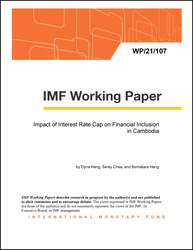
Impacts of Interest Rate Cap on Financial Inclusion in Cambodia
Impacts of Interest Rate Cap on Financial Inclusion in Cambodia
READ MORE...
Volume/Issue:
Volume 2021
Issue 107
Publication date: April 2021
ISBN: 9781513582634
$18.00
Add to Cart by clicking price of the language and format you'd like to purchase
Available Languages and Formats
| English |
Prices in red indicate formats that are not yet available but are forthcoming.
Topics covered in this book
This title contains information about the following subjects.
Click on a subject if you would like to see other titles with the same subjects.
Banks and Banking , Finance , Economics- Macroeconomics , Money and Monetary Policy , Economics / General , International - Economics , Financial Inclusion , Interest Rate Caps , Banking Sector , microfinance borrower , microfinance-loan interest rate caps , operation cost , supervisory data , impact of interest rate cap , Loans , Interest rate ceilings , Microfinance , Financial inclusion , Credit , Global
Also of interest
Summary
Interest rate caps, despite their intended objective of broadening financial inclusion, can have undesirable effects on financial inclusion under certain conditions. This paper examines the effect of microfinance-loan interest rate caps on financial inclusion in Cambodia. Based on a difference-in-difference analysis on bank and microfinance supervisory data, results show some unintended impact on financial inclusion. The cap led to a significant increase in non-interest fees charged on new loans following the introduction of an annual cap. Microfinance borrowers declined immediately, amid an increase in credit growth, as microfinance institutions targeted larger borrowers at the expense of smaller ones. Microfinance institutions, responded differently to the cap, considering their own operation and funding costs, and client base. Two years after the cap, institutions resumed lending to a wider group of borrowers with lower funding and operation costs brought by mobile payment development.
Copyright © 2010 - 2025
Powered by:
AIDC



